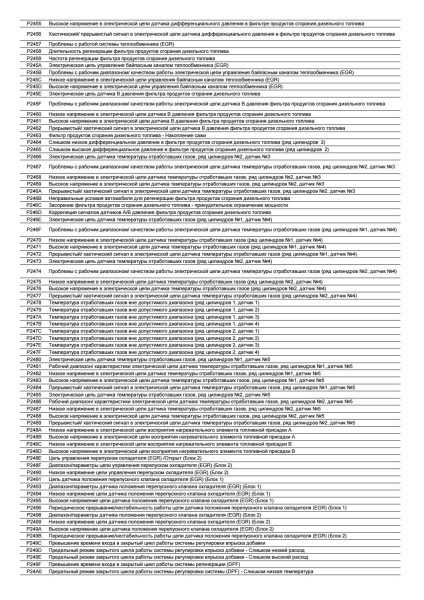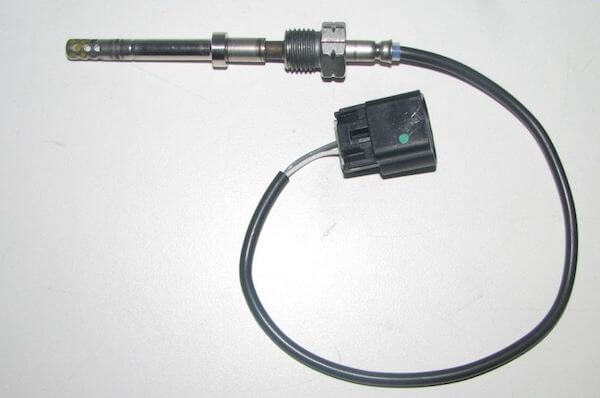
P2478 Exhaust Gas Temperature Out of Range Bank 1 Sensor 1
Content
- P2478 Exhaust Gas Temperature Out of Range Bank 1 Sensor 1
- OBD-II DTC Datasheet
- What does this mean?
- What is the severity of this DTC?
- What are some of the symptoms of the code?
- What are some of the common causes for the code?
- What are some steps to troubleshoot the P2478?
- What are the standard ways to fix this code?
- Related DTC discussions
- Need more help with the P2478 code?
P2478 Exhaust Gas Temperature Out of Range Bank 1 Sensor 1
OBD-II DTC Datasheet
Exhaust Gas Temperature Out of Range Bank 1 Sensor 1
What does this mean?
This is a generic Diagnostic Trouble Code (DTC) applicable to many OBD-II vehicles (1996 and newer). This may include, but is not limited to, Ford, VW, Volkswagen, Audi, Porsche, Chevy, Nissan, etc. Despite the general nature, the exact repair steps may vary depending on the model year, make, model and transmission configuration. ...
OBD-II DTC P2478 relates to exhaust gas temperature out of range, bank 1 sensor circuit 1. When the engine control unit (ECU) detects abnormal signals in the exhaust gas temperature circuit, P2478 will set and the engine light will illuminate. Consult vehicle specific resources to determine the appropriate bank and gauge location for your specific year / make / model / engine combination.
The exhaust gas temperature sensor monitors the exhaust gas temperature and converts it into a voltage signal that is sent to the ECU. The ECU uses the input to control the state of the engine and effectively reduce emissions. The ECU recognizes these voltage fluctuations and responds accordingly by adjusting the ignition timing or the air / fuel mixture to lower the exhaust gas temperature and protect the catalytic converter. Exhaust gas temperature sensors are built into diesel engines, gasoline engines and even turbocharged engines. This process also improves productivity and fuel economy.
Typical EGT Exhaust Gas Temperature Sensor: 
What is the severity of this DTC?
The severity of this code can vary greatly from a simple check engine light on a car that starts and moves to a car that stalls or won't start at all.
What are some of the symptoms of the code?
Symptoms of a P2478 trouble code may include:
- Engine may stall
- Engine won't start
- Engine may overheat
- Poor fuel economy
- Low productivity
- Check engine light is on
What are some of the common causes for the code?
Reasons for this P2478 code may include:
- Defective exhaust gas temperature sensor
- Excessive exhaust gas leak
- Blown fuse or jumper wire (if applicable)
- Excessive carbon build-up on the sensor
- Corroded or damaged connector
- Faulty or damaged wiring
- Defective ECU
What are some steps to troubleshoot the P2478?
The first step in troubleshooting any problem is to review the vehicle-specific Technical Service Bulletins (TSBs) by year, model, and powerplant. In some cases, this can save you a lot of time in the long run by pointing you in the right direction.
The second step is to locate all the components in that circuit and perform a thorough visual inspection to check the associated wiring for obvious defects such as scratches, abrasions, exposed wires, or burn marks. Next, you should check the connectors for security, corrosion and damage to the contacts. The exhaust gas temperature sensor is usually a two-wire sensor located in the exhaust pipe. The exhaust gas temperature sensor should be removed to check for excessive carbon buildup. This process should also include identifying any possible exhaust leaks.
Advanced steps
The additional steps become very specific to the vehicle and require the appropriate advanced equipment to be accurately performed. These procedures require a digital multimeter and vehicle specific technical reference documents. The ideal tools to use in this situation are an infrared thermometer and a heat gun if available. Voltage requirements depend on the year of manufacture and vehicle model.
Voltage test
The output voltage of the exhaust gas temperature sensor should vary in proportion to temperature changes. If the voltage remains the same or changes rapidly, this indicates that the exhaust gas temperature sensor needs to be replaced.
If this process detects that a power source or ground is missing, a continuity check may be required to verify the integrity of wiring, connectors, and other components. Continuity tests should always be done with power disconnected from the circuit and normal wiring and connection readings should be 0 ohms of resistance. Resistance or no continuity indicates faulty wiring that is open or shorted and requires repair or replacement. The resistance level of the exhaust gas temperature sensor should vary in proportion to the temperature rise and fall. Depending on the type of sensor, the resistance should increase or decrease as the temperature rises, and a heat gun can be used to perform a bench test on this component. There are two types of exhaust gas temperature sensors: NTC and PTC. A NTC sensor has high resistance at low temperatures and low resistance at high temperatures. A PTC sensor has low resistance at low temperatures and high resistance at high temperatures.
What are the standard ways to fix this code?
- Exhaust Gas Temperature Sensor Replacement
- Replacing a blown fuse or fuse (if applicable)
- Cleaning connectors from corrosion
- Repair or replace faulty wiring
- Removing carbon deposits from the sensor
- Eliminate Exhaust Gas Leak
- ECU firmware or replacement
Common mistakes can include:
The problem is replacing the ECU or exhaust gas temperature sensor if the wiring or other component is damaged. O2 sensors are also often mistaken for an exhaust gas temperature sensor.
I hope the information in this article has helped you point the right direction for solving the problem related to the exhaust gas temperature out of range, bank 1 sensor circuit fault code. This article is for informational purposes only, and specific technical data and service bulletins for your vehicle should always take precedence.
Related DTC discussions
- There are currently no related topics in our forums. Post a new topic on the forum now.
Need more help with the P2478 code?
If you still need help with DTC P2478, post a question in the comments below this article.
NOTE. This information is provided for informational purposes only. It is not intended to be used as a repair recommendation and we are not responsible for any action you take on any vehicle. All information on this site is protected by copyright.